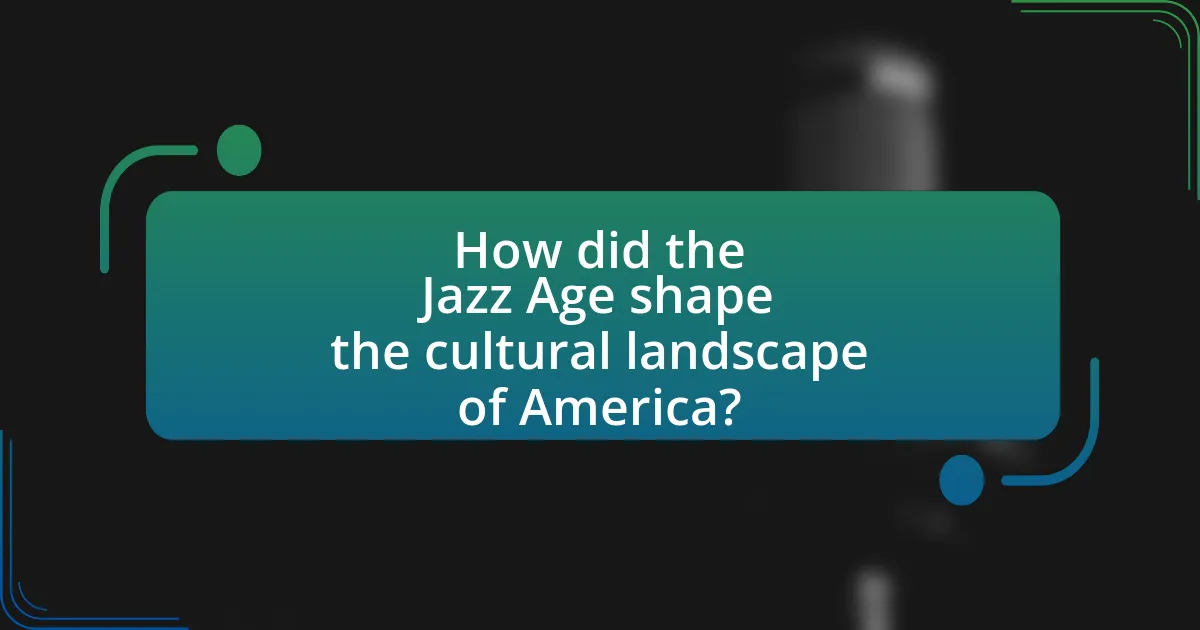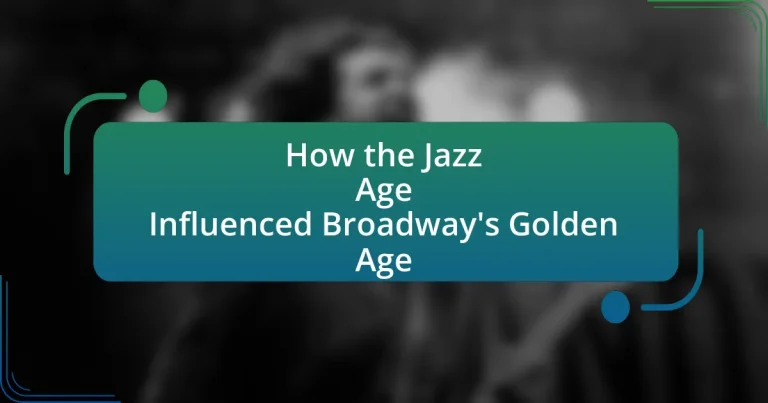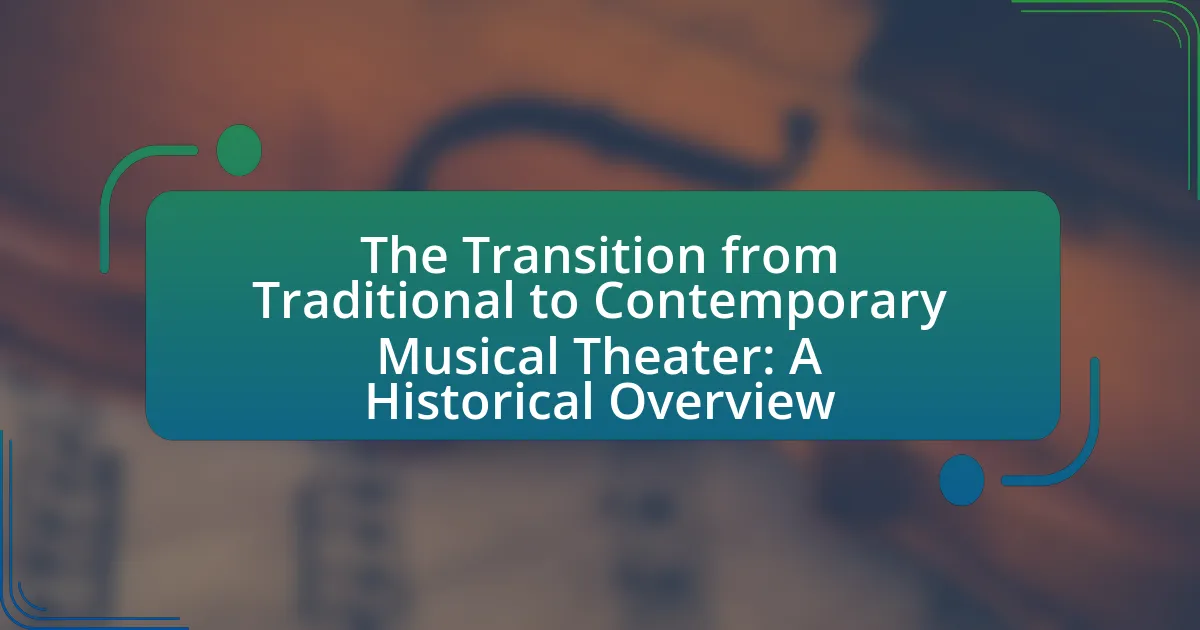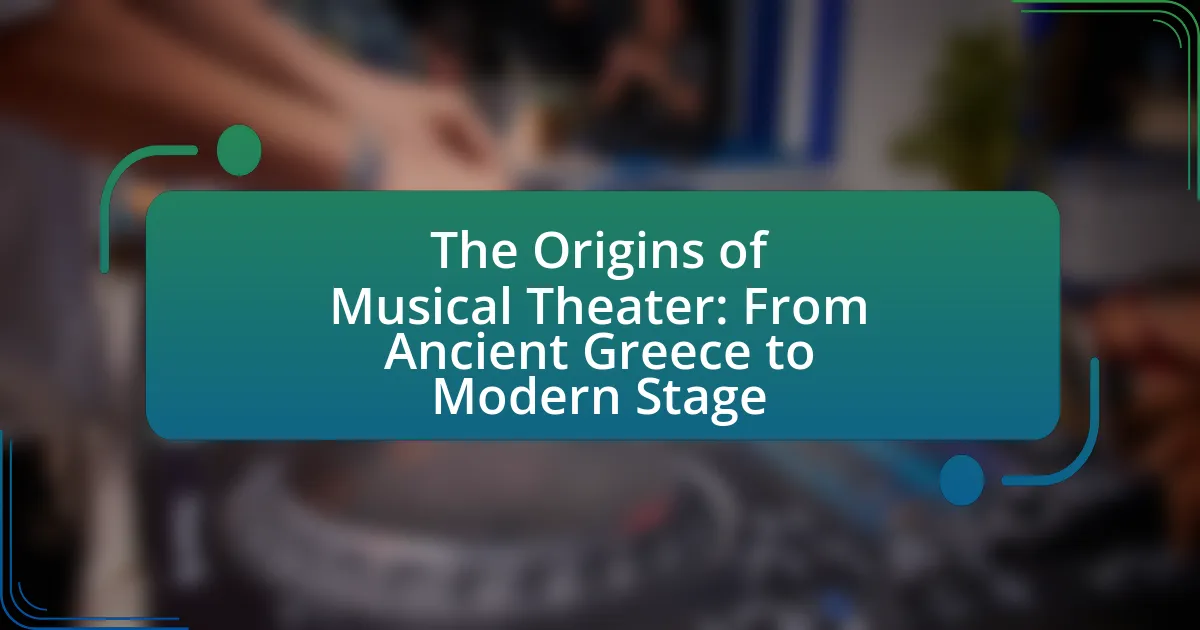The article examines how the Jazz Age, spanning the 1920s, significantly influenced Broadway’s Golden Age, which occurred from the late 1940s to the early 1960s. It highlights the emergence of jazz music as a dominant cultural force that reshaped musical theater through innovative rhythms, themes of social change, and character development. Key aspects discussed include the integration of jazz into Broadway productions, the impact of the Harlem Renaissance, and the evolution of storytelling and performance styles. Additionally, the article explores notable figures and productions that exemplified this transformative relationship, illustrating the lasting legacy of the Jazz Age on American entertainment.

How did the Jazz Age shape the cultural landscape of America?
The Jazz Age significantly shaped the cultural landscape of America by fostering a spirit of innovation and liberation in music, art, and social norms. This period, spanning the 1920s, saw the rise of jazz music as a dominant genre, influencing not only musical styles but also dance, fashion, and social interactions. The Harlem Renaissance, a cultural movement during this time, highlighted African American artists and writers, leading to a broader acceptance of diverse cultural expressions. The proliferation of jazz clubs and speakeasies created new social spaces that challenged traditional values, promoting a sense of freedom and experimentation. This cultural shift laid the groundwork for Broadway’s Golden Age, as the popularity of jazz music inspired new theatrical productions and musical styles, ultimately transforming American entertainment.
What were the defining characteristics of the Jazz Age?
The defining characteristics of the Jazz Age include a cultural shift towards modernism, the rise of jazz music, and significant social changes such as the liberation of women and the emergence of a consumer-driven economy. This period, primarily during the 1920s, was marked by the popularity of jazz as a musical genre, which reflected the era’s spirit of innovation and rebellion against traditional norms. The introduction of the flapper symbolized women’s newfound independence, as they embraced more liberal lifestyles, including fashion and social behaviors. Additionally, the economic prosperity of the time led to increased consumerism, with people spending on entertainment, fashion, and leisure activities, which significantly influenced the arts, including Broadway productions that began to incorporate jazz elements and themes reflective of contemporary society.
How did music and dance influence social interactions during the Jazz Age?
Music and dance significantly influenced social interactions during the Jazz Age by fostering a sense of community and breaking down social barriers. The emergence of jazz music, characterized by its improvisational style and syncopated rhythms, encouraged people to gather in social venues like speakeasies and dance halls, where they engaged in lively interactions. The popularity of dance styles such as the Charleston and the Lindy Hop not only provided entertainment but also served as a means for individuals from diverse backgrounds to connect and express themselves. Historical evidence shows that these social gatherings often included people from different races and social classes, promoting a more inclusive atmosphere. The cultural shift during this period was marked by the Harlem Renaissance, which highlighted the contributions of African American artists and musicians, further enriching social dynamics and interactions.
What role did prohibition play in the emergence of jazz culture?
Prohibition significantly contributed to the emergence of jazz culture by creating an underground environment where jazz music thrived in speakeasies and illegal bars. The 18th Amendment, enacted in 1920, banned the sale of alcohol, leading to the rise of clandestine venues that became hotspots for jazz musicians and audiences seeking entertainment. These speakeasies not only provided a space for jazz to flourish but also fostered a sense of community and cultural exchange among diverse groups, including African Americans and immigrants, who played pivotal roles in shaping the genre. The demand for lively music in these venues propelled jazz into the mainstream, making it a defining sound of the Roaring Twenties and influencing subsequent musical styles.
How did the Jazz Age impact the arts and entertainment industry?
The Jazz Age significantly transformed the arts and entertainment industry by introducing new musical styles, dance forms, and cultural expressions that shaped popular culture. This era, spanning the 1920s, saw the rise of jazz music, which became a dominant genre, influencing Broadway productions and leading to the creation of iconic musicals such as “Show Boat” and “Porgy and Bess.” The integration of jazz into theater not only attracted diverse audiences but also encouraged innovative choreography and performance styles, exemplified by the works of choreographers like George Balanchine. Additionally, the proliferation of radio and phonograph records during this time facilitated the widespread dissemination of jazz, further embedding it into the fabric of American entertainment. The impact of the Jazz Age on the arts and entertainment industry is evident in the lasting legacy of its music and dance, which continue to influence contemporary performances.
What new artistic movements emerged during the Jazz Age?
During the Jazz Age, new artistic movements such as Art Deco and Surrealism emerged. Art Deco, characterized by its bold geometric shapes and vibrant colors, reflected the modernity and luxury of the era, influencing architecture, fashion, and visual arts. Surrealism, on the other hand, sought to explore the unconscious mind and dream imagery, with artists like Salvador Dalí and René Magritte gaining prominence. These movements were significant as they represented a departure from traditional artistic expressions, aligning with the cultural shifts of the 1920s, which were marked by innovation and a break from convention.
How did jazz music influence other art forms, such as literature and visual arts?
Jazz music significantly influenced literature and visual arts by introducing improvisation, rhythm, and a focus on individual expression. In literature, authors like Langston Hughes and Zora Neale Hurston incorporated jazz rhythms and themes into their poetry and prose, reflecting the cultural dynamics of the Harlem Renaissance. Visual artists, such as Aaron Douglas and Romare Bearden, drew inspiration from jazz’s vibrant energy and spontaneity, using bold colors and dynamic forms to capture the essence of the music. This cross-pollination of jazz with other art forms helped to shape modern artistic expression and fostered a new cultural identity during the Jazz Age.
What is Broadway’s Golden Age?
Broadway’s Golden Age refers to the period from the late 1940s to the early 1960s when musical theater flourished in New York City, characterized by innovative productions and significant cultural impact. During this era, landmark shows such as “Oklahoma!” (1943), “South Pacific” (1949), and “West Side Story” (1957) emerged, showcasing complex narratives, sophisticated scores, and integration of music and story. This period is marked by the collaboration of influential composers and lyricists like Rodgers and Hammerstein, Leonard Bernstein, and Stephen Sondheim, who transformed the musical landscape. The Golden Age is often cited as a time when Broadway became a central part of American culture, reflecting societal changes and artistic advancements.
What time period is considered Broadway’s Golden Age?
Broadway’s Golden Age is considered to span from the late 1940s to the early 1960s. This period is marked by the emergence of significant musical theater works, including classics like “Oklahoma!” (1943), “South Pacific” (1949), and “West Side Story” (1957). The era is characterized by innovative storytelling, memorable scores, and the integration of music and narrative, which set a high standard for future productions.
What were the major musical and theatrical innovations during this period?
The major musical and theatrical innovations during the Jazz Age included the integration of jazz music into Broadway productions and the development of the musical as a distinct art form. The incorporation of jazz rhythms and styles transformed the sound of musical theater, exemplified by shows like “Rhapsody in Blue” and “Porgy and Bess,” which showcased the genre’s influence. Additionally, the rise of the book musical, where songs and dances were woven into a cohesive narrative, marked a significant evolution in theatrical storytelling. This period also saw advancements in stage technology, such as electric lighting and sound amplification, enhancing the overall theatrical experience. These innovations collectively shaped the trajectory of Broadway, establishing it as a vibrant cultural hub.
How did Broadway productions evolve in terms of storytelling and performance?
Broadway productions evolved significantly in storytelling and performance by transitioning from traditional narratives to more complex, character-driven plots that reflected contemporary societal changes. During the Jazz Age, musicals began to incorporate elements of jazz music and dance, which influenced the pacing and energy of performances, allowing for a more dynamic and engaging audience experience. This period saw the emergence of integrated musicals, where songs and dances were essential to the narrative, exemplified by works like “Show Boat” (1927) and “Porgy and Bess” (1935), which addressed social issues and showcased diverse characters. The shift towards a more cohesive storytelling approach marked a departure from the earlier vaudeville style, emphasizing emotional depth and character development, thus laying the groundwork for the Golden Age of Broadway.
What were the key influences on Broadway during its Golden Age?
The key influences on Broadway during its Golden Age included the rise of jazz music, the impact of the Great Depression, and the evolution of musical theater styles. Jazz music, which gained popularity in the 1920s, infused Broadway productions with new rhythms and styles, leading to innovative compositions and performances. The Great Depression prompted a shift in themes, with shows often reflecting the struggles and aspirations of everyday Americans, as seen in productions like “Porgy and Bess” and “Oklahoma!” Additionally, the integration of dance and storytelling in musicals became more pronounced, exemplified by the works of choreographers like George Balanchine and directors such as Rodgers and Hammerstein, who revolutionized the genre. These elements collectively shaped the artistic landscape of Broadway during this transformative period.
How did the Jazz Age contribute to the themes and styles of Broadway musicals?
The Jazz Age significantly influenced the themes and styles of Broadway musicals by introducing elements of jazz music, dance, and a focus on modernity and social change. This era, spanning the 1920s, saw the incorporation of syncopated rhythms and improvisational styles characteristic of jazz, which transformed the musical landscape on Broadway. Notable musicals such as “Rhapsody in Blue” and “Porgy and Bess” showcased these jazz elements, reflecting the cultural shifts of the time, including the rise of urban life and the flapper movement. The themes often revolved around liberation, romance, and the pursuit of happiness, mirroring the societal changes and the spirit of the Roaring Twenties. This integration of jazz not only shaped the sound of Broadway but also influenced the narrative styles, leading to more dynamic and engaging performances that resonated with contemporary audiences.
What notable figures from the Jazz Age made significant contributions to Broadway?
Notable figures from the Jazz Age who made significant contributions to Broadway include George Gershwin, Cole Porter, and Ethel Waters. George Gershwin is renowned for his groundbreaking musical “Porgy and Bess,” which integrated jazz elements into opera, while Cole Porter is celebrated for his sophisticated lyrics and melodies in shows like “Anything Goes.” Ethel Waters broke racial barriers and brought a unique vocal style to Broadway, notably in “As Thousands Cheer.” These artists not only shaped the sound and style of Broadway during the Jazz Age but also laid the groundwork for the musical theater that followed, influencing countless productions and composers in the years to come.
How did the Jazz Age directly influence Broadway’s Golden Age?
The Jazz Age directly influenced Broadway’s Golden Age by introducing new musical styles, themes, and cultural attitudes that reshaped theatrical productions. The emergence of jazz music in the 1920s brought a vibrant, energetic sound that was incorporated into Broadway shows, leading to the creation of musicals that reflected the era’s spirit of innovation and social change. Notable productions like “Show Boat” (1927) and “Porgy and Bess” (1935) showcased jazz elements, blending traditional musical theater with contemporary rhythms and narratives. This fusion not only attracted diverse audiences but also set the stage for the evolution of American musical theater, establishing Broadway as a central hub for artistic expression during the Golden Age.
What musical elements from the Jazz Age were incorporated into Broadway shows?
The musical elements from the Jazz Age incorporated into Broadway shows include syncopated rhythms, improvisation, and jazz harmonies. Syncopated rhythms became a defining characteristic of Broadway scores, reflecting the lively and energetic nature of jazz music. Improvisation, a hallmark of jazz performance, influenced the way performers interpreted songs, allowing for more expressive and dynamic presentations. Additionally, jazz harmonies, characterized by extended chords and unique progressions, enriched the musical texture of Broadway compositions, contributing to the innovative sound of the era. These elements collectively transformed Broadway, making it a vibrant platform for the fusion of popular music styles during the Jazz Age.
How did jazz rhythms and improvisation change musical composition on Broadway?
Jazz rhythms and improvisation significantly transformed musical composition on Broadway by introducing syncopation and a more fluid, spontaneous approach to melody and harmony. This shift allowed composers to break away from traditional structures, leading to innovative arrangements that incorporated elements of jazz, such as swing and blues influences. Notably, shows like “Porgy and Bess” by George Gershwin in 1935 exemplified this change, blending classical forms with jazz idioms, which expanded the emotional range and complexity of Broadway music. The integration of jazz not only enriched the musical landscape but also reflected the cultural zeitgeist of the Jazz Age, making Broadway a vibrant platform for artistic expression.
What impact did jazz artists have on Broadway’s performance styles?
Jazz artists significantly transformed Broadway’s performance styles by introducing improvisation, syncopation, and a more expressive form of musicality. This shift was evident in the integration of jazz elements into Broadway scores, which allowed for greater emotional depth and dynamic expression in performances. Notably, shows like “Porgy and Bess” by George Gershwin in 1935 showcased jazz-infused melodies and rhythms, reflecting the cultural zeitgeist of the Jazz Age. The influence of jazz artists also led to a more relaxed and conversational style of singing and acting, moving away from the more formal and rigid performances of earlier eras. This evolution in performance style not only enriched the theatrical experience but also attracted a broader audience, ultimately shaping the identity of American musical theater.
How did the cultural themes of the Jazz Age manifest in Broadway productions?
The cultural themes of the Jazz Age manifested in Broadway productions through the incorporation of jazz music, flapper culture, and themes of modernity and social change. Broadway shows during this period, such as “Rhapsody in Blue” and “Lady, Be Good!”, prominently featured jazz rhythms and styles, reflecting the era’s musical innovation. The portrayal of flappers, who embodied the spirit of liberation and defiance against traditional norms, became central to many productions, showcasing women’s evolving roles in society. Additionally, the themes of urban life, economic prosperity, and the quest for identity were prevalent, as seen in works like “Porgy and Bess,” which highlighted the complexities of African American life in a rapidly changing America. These elements collectively illustrate how Broadway served as a mirror to the cultural dynamism of the Jazz Age.
What social issues addressed in Jazz Age music were reflected in Broadway narratives?
Jazz Age music addressed several social issues that were reflected in Broadway narratives, including racial inequality, gender roles, and the pursuit of the American Dream. For instance, the Harlem Renaissance, which coincided with the Jazz Age, highlighted the struggles and cultural contributions of African Americans, influencing Broadway shows like “Porgy and Bess,” which depicted the lives of Black characters facing systemic racism. Additionally, the era’s music often challenged traditional gender norms, as seen in productions like “Lady, Be Good!” that featured strong female leads and themes of female independence. The pursuit of the American Dream was also a recurring theme, illustrated in shows like “Chicago,” which critiqued the moral decay and ambition of the time. These narratives not only reflected the social climate of the Jazz Age but also engaged audiences in conversations about these pressing issues.
How did the celebration of jazz culture influence character development in musicals?
The celebration of jazz culture significantly influenced character development in musicals by introducing complex, dynamic characters that reflected the social changes of the Jazz Age. This era, characterized by the rise of jazz music, allowed for the exploration of themes such as freedom, rebellion, and the pursuit of happiness, which were embodied in characters who often defied traditional norms. For instance, musicals like “Porgy and Bess” and “Cabaret” featured characters that navigated the complexities of race, sexuality, and identity, showcasing the impact of jazz on their personal journeys. The improvisational nature of jazz also encouraged characters to express themselves more freely, leading to richer, more authentic portrayals. This shift in character development can be traced back to the cultural significance of jazz, which served as a backdrop for the evolving narratives in Broadway musicals during this transformative period.
What lessons can be learned from the intersection of the Jazz Age and Broadway’s Golden Age?
The intersection of the Jazz Age and Broadway’s Golden Age teaches the importance of cultural innovation and the blending of artistic forms. During the Jazz Age, which spanned the 1920s, jazz music became a dominant cultural force, influencing Broadway productions that incorporated jazz rhythms and styles, leading to a new form of musical theater. Notable examples include “Porgy and Bess” by George Gershwin, which premiered in 1935 and showcased jazz elements, reflecting the era’s cultural shifts. This blending of genres not only expanded the musical landscape but also highlighted the significance of social themes, such as race and identity, which were prevalent in both jazz music and Broadway narratives. The success of this fusion illustrates how embracing diverse influences can lead to groundbreaking artistic expressions and resonate with broader audiences.
How can contemporary artists draw inspiration from this historical relationship?
Contemporary artists can draw inspiration from the historical relationship between the Jazz Age and Broadway’s Golden Age by exploring themes of innovation, cultural fusion, and social change. The Jazz Age, characterized by its vibrant music and dance, influenced Broadway productions by introducing jazz elements into musical scores and choreography, which artists can reinterpret in modern contexts. For instance, the integration of jazz rhythms and improvisation techniques in contemporary performances can evoke the spirit of the 1920s while addressing current societal issues. This connection is evident in works like “Hamilton,” where hip-hop and jazz converge to tell historical narratives, reflecting the transformative impact of the Jazz Age on artistic expression.
What best practices can be applied to modern musical theater from this era?
Best practices that can be applied to modern musical theater from the Jazz Age include the integration of jazz music and dance styles, the emphasis on character-driven storytelling, and the use of innovative staging techniques. The incorporation of jazz elements, as seen in productions like “Porgy and Bess,” enhances the emotional depth and cultural relevance of the narrative. Character-driven storytelling, exemplified by shows such as “Show Boat,” allows for complex character arcs that resonate with contemporary audiences. Additionally, innovative staging techniques, including the use of dynamic set designs and lighting, can create immersive experiences, similar to the groundbreaking approaches of the era. These practices not only honor the legacy of the Jazz Age but also enrich modern musical theater by fostering creativity and engagement.




